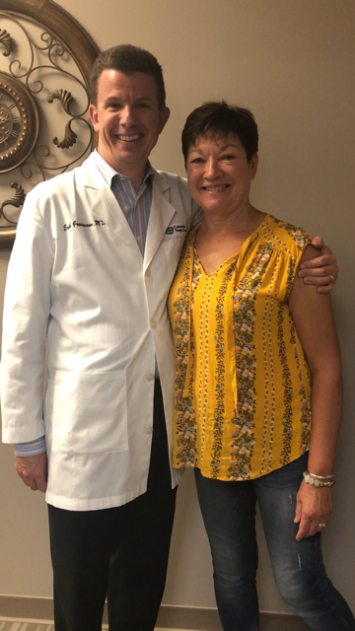Screening and Early Detection is Key to Effective Treatment
Colorectal cancer (cancer of the colon and rectum) is the second leading cause of cancer death in men and women in the United States after lung cancer. Colorectal cancer develops from precancerous polyps (abnormal growths) in the colon or rectum. Finding and removing polyps reduces the risk for colorectal cancer.

For Luan Chesshir, at age 50 during a routine screening procedure, found a small cancerous polyp in her colon. Luan did not have a family history, lead a healthy lifestyle and as many times with early-stage colorectal cancer, Luan didn’t have any symptoms.
"A colonoscopy screening not only detects colorectal cancers but also prevents it by finding polyps, making it both diagnostic and preventative" said Columbia Surgical Associates Colorectal Surgeon Dr. Erik Grossmann.
Research suggests that colonoscopy reduces deaths from colorectal cancer by about 60 to 70%. There are others screening methods that can be useful and your doctor may recommend. They can include in combination:
- Stool tests: Colorectal cancers often release microscopic amounts of blood and abnormal DNA into the stool. Stool tests can detect blood or abnormal DNA markers. Two types of tests, called guaiac tests (Hemoccult SENSA) and immunochemical tests, evaluate the stool for blood, which may be present if there is bleeding from a colon cancer (or other source of blood). Stool tests are recommended every one to two years.
- Colonoscopy (scope): Allows the clinician to directly view the lining of the colon and rectum. This visualization allows for biopsy of any abnormal growths such as polyps or cancerous lesions. Screening colonoscopy should begin at age 50. The interval for follow up colonoscopies will be determined based on the results of the previous scope. Colonoscopy remains the "gold standard" for the early detection and treatment of colorectal cancer.
- Sigmoidoscopy: Allows clinician to directly view the lining of the rectum and the lower part of the colon for polyps and cancer. Abnormal growths can be removed for testing (biopsied).
- CT Colonography: “Virtual colonoscopy” is a test that uses a CT scanner to take images of the entire colon. These images are two- and three-dimensional and are reconstructed to allow a radiologist to determine if polyps or cancers are present or show any abnormalities. CT colonography is recommended every five years.
Screenings and a healthy lifestyle choice can help lower your risk of developing colorectal cancer. For people with average risk, colonoscopy is recommended every 10 years.
Screening recommendations for colorectal cancer
- Get screened regularly beginning at age 50
- Exercise and maintain a normal body weight
- Do not smoke
- Drink alcohol in moderation
- Eat fruits, vegetables, high-fiber foods and avoid a high fat diet
If you, or your family members have colon polyps or have had colorectal cancer, you will need a colonoscopy earlier in life, and more often. Talk to your doctor. If you are seeing blood in your stool, you need to talk to your doctor about it now.
For more information on screening recommendations, read "What Should I Know About Colorectal Cancer Screening?"
 “People shouldn’t avoid a colonoscopy due to prep, it’s not fun, but I can’t image that chemotherapy or radical surgery would be either” said Luan “Unfortunately, only a little more than half of people who should get tested for colorectal cancer get the tests that they should. As a woman you have to be your own advocate and ask to be screened if your primary care physician isn’t talking to you about yearly health screenings.”
“People shouldn’t avoid a colonoscopy due to prep, it’s not fun, but I can’t image that chemotherapy or radical surgery would be either” said Luan “Unfortunately, only a little more than half of people who should get tested for colorectal cancer get the tests that they should. As a woman you have to be your own advocate and ask to be screened if your primary care physician isn’t talking to you about yearly health screenings.”
-- Luan Chesshir

Leave a Reply